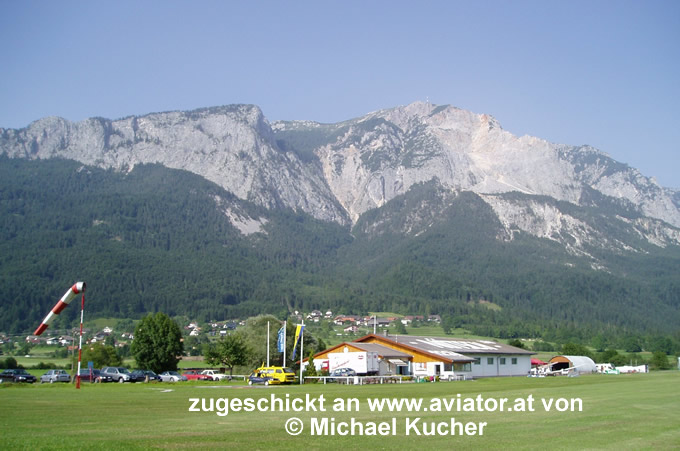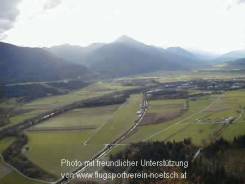Nötsch im Gailtal
Notsch iG ( Slow Cajna ) is a market town with 2261 inhabitants (as of 1 January 2013 ) in the district of Villach-Land.
- 3.1 Demographics
- 4.1 Museums
- 4.2 Structures
- 4.3 Regular events
- 5.1 municipal
- 5.2 Coat of Arms
Geography
Geographical location
The municipality is located in the Gail Valley in Southern Carinthia at the foot of Villacheralpe ( Dobratsch ).
Community structure
The municipality is divided into three cadastral Kerschdorf iG ( Črešnje ) Saak ( Čače ) and Sankt Georgen ( Šentjurij ) divided. The municipality includes the following 17 places (in brackets population as of 31 October 2011):
- Bach / Potok (48 )
- Dellach / Dole ( 10)
- Emmer Village / Šmerče (50 )
- Förk / Borče (108 )
- Glabatschach / Globače (9 )
- Hermsberg / rod (22 )
- Kerschdorf / Črešnje (141 )
- Kreublach / Hriblje (35 )
- Kühweg / Skovče (61 )
- Labientschach / Labenče (207 )
- Michel Mayrhofen / Mišelče (38 )
- Notsch / Cajna ( 967 )
- Poglantschach / Poklanče (18 )
- Saak / Čače (284 )
- Sankt Georgen iG / Šentjurij v Ziljski dolini (120 )
- Semering / Semreče (75 )
- Wertschach / DVORCE (90 )
History
Mention the place Notsch was already in 1253rd
In Notsch iG there have always been large floods, which often involved the entire valley. The earthquake of 25 January 1348 sparked the Dobratsch from a landslide that caused at today Nötscher municipality an impoundment of the Gail and destroyed numerous buildings. More Gailüberschwemmungen in 1848 and 1851 also had devastating consequences, including many bridges were destroyed.
With the constitution of political communities in Carinthia 1850, the local church Emmer village was formed. It was renamed in 1960 Notsch iG. In 1999, the municipality the right to use the designation " market town ".
Even in 1924 the parishes of St. Paul to the Gail / Šentpavel na Zilji were Slovenian, as well as the parish Vorderberg / Blace and in the bilingual designated parish Sankt Georgen / Šentjurij the affiliated churches Emmer Village / Smerče Kerschdorf / Črešnje and drafts / Pešišče were only performed Slovenian. Bilingual parish Saak / Čače was performed. Only the branch church in Castle Wasserleonburg was led German.
Population
According to 2001 census Notsch has 2,352 inhabitants, of which 96.9 % have Austrian citizenship.
89.0 % of the population are Roman Catholics, 4.9% to 1.4% are Protestant Church and the Islamic faith; 3.4 % have no religious confession.
Demographics
Culture and sights
Museums
- Museum of Nötscher painter circle
Structures
- The parish church of Holy Kanzian in Saak is erected in the second half of the 15th century in the late Gothic style church. The porch dates from the 18th century. Nave and choir are under the stars or network vaults. On the Baroque high altar (around 1740) is a group of figures Kanzius, holy and sacred Kanzianus Kanzianilla ( 1600). Side altar in 1690 with Late Gothic statue of Mary. Pulpit dated 1685, at the pulpit flower pictures. Holy grave chapel with Golgothagruppe, built in 1768. On the southern outer wall view of a "Holiday Christ " in 1500, surrounded by the tools of the forbidden on Sundays and public holidays activities. Another exterior fresco dates from the year 1924. Inside the church there are frescoes from 1465 and 1516.
- Cemetery in Saak: the grave of Michor family is surrounded with the fresco of the Madonna and Child, by angels playing instruments, the most important preserved monumental work of Anton Kolig, painted from 1927 to 1929 on behalf of Peter Michor on the southern church facade. On the southern outer wall of the presbytery the grave of Anton Kolig with a small Mosaiktondo after its design ( around 1927 ). In the southeastern corner of the cemetery, the grave of Franz Wiegele, on the southern cemetery wall of the grave Isepp Hubert, brother of the painter Sebastian Isepp, on the western part of the cemetery, the grave of his niece Christine, the wife of the painter Gerhart Frankl.
- The Wasserleonburg Castle in Saak was first mentioned in 1253 and was originally called the Lion's Castle. Significantly, the late Mannerist courtyard façade, which was built around 1650, also notable is the Renaissancelaubenhof and the castle chapel.
- Windische chapel at Dobratsch
Regular events
- Every March 19 organized a big " Josefimarkt ".
- Every year instead of the Gail Valley Parish with the Kufenstechen and the Linde dance in July and August.
- At the annual festival in October polenta polenta dishes and other culinary specialties of the region are served.
Policy
Parish council
The local council of Notsch has 19 members and is composed as follows since the municipal elections in 2009 together:
Directly elected mayor since 2009, Johann Müller ( SPÖ).
Coat of arms
The design of the coat of arms of Notsch has the oldest known seal of the owner of the Wasserleonburg to content. It is a Cholo de Lewenburg ( Lion's Castle ), which was first mentioned in 1250 in records and whose seal is found in a document from 1258. The upright, border to the right and hersehende lion is sure in connection with the name of the castle, where also a reference to the Bishopric of Bamberg is regarded as original lords as likely.
Coat of arms and flag were presented to the community on June 15, 1960, the flag is yellow-blue with integrated crest.
Personalities
- Sebastian Isepp (1884-1954), painter of the circle Nötscher
- Vincent Schumy (1878-1962), Governor of Carinthia, Austrian Minister of the Interior ( 1st Republic )
- Franz Wiegele (1887-1944), painter of the circle Nötscher










